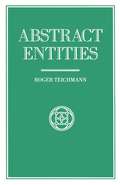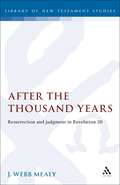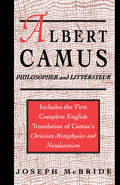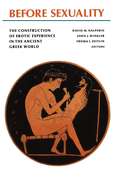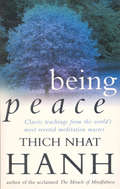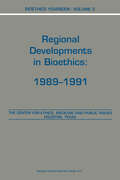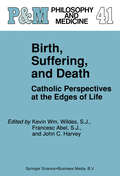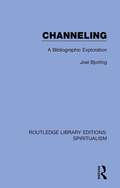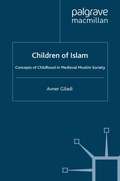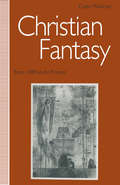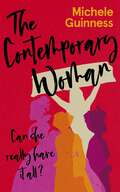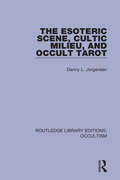- Table View
- List View
King Saul in the Historiography of Judah (The Library of Hebrew Bible/Old Testament Studies)
by Diana Vikander EdelmanA sustained close reading of 1 Samuel 8 to 2 Samuel 1 from the perspective of the intended ancient audience. A conscious effort is made here to read and understand the text 'through the eyes of an ancient Israelite', to the extent that the world-view and idioms of late seventh-century Judah can be reconstructed. The study reveals a coherent, carefully developed narrative of Saul's career as the first king of Israel.
Female Piety in Puritan New England: The Emergence of Religious Humanism (Religion in America)
by Amanda PorterfieldA synthesis of literary critical and historical methods, Porterfield's book combines insightful analysis of Puritan theological writings with detailed examinations of historical records showing the changing patterns of church membership and domestic life. She finds that by conflating marriage as a trope of grace with marriage as a social construct, Puritan ministers invested relationships between husbands and wives with religious meaning. Images of female piety represented the humility that Puritans believed led all Christians to self-control and, ultimately, to love. But while images of female piety were important for men primarily as aids to controlling aggression and ambition, they were primarily attractive to women as aids to exercising indirect influence over men and obtaining public recognition and status.
Biblical Sound and Sense: Poetic Sound Patterns in Proverbs 10-29 (The Library of Hebrew Bible/Old Testament Studies)
by Thomas P. McCreeshThe first chapter of this unusual and instructive work shows how the study of sound patterns in Old Testament Hebrew poetry is integral to the investigation of bublical poetry. Then several chapters describe and systematize the sound patterns, beginning with simpler examples of assonance and alliteration. The analysis gradually moves on to more complex configurations which link words and phrases, emphasize key words, mark off syntactical and semantic units, and highlight word repetition and word play. A relationship between sound pattern and meaning in each proverb is shown throughout.
After the Thousand Years: Resurrection and Judgment in Revelation 20 (The Library of New Testament Studies #70)
by J. Webb MealyA fresh and highly illuminating approach to what is perhaps the most difficult chapter in the most difficult book of the New Testament. Mealy employs a carefully developed methodology which draws fully on the special literary techniques of Revelation, particularly its extensive use of internal cross-references, multivalent images and symbols, and complex Old Testament reminiscences. With its central thesis that Revelation 20.7-10 and 20.11-15 offer parallel representations of the resurrection and final judgment of the unrepentant, this study is destined to become a benchmark for future discussions not only of the millennium, but of the literary workings of Revelation as a whole.
Albert Camus: Philosopher and Littrateur
by J. McBrideThis book marks a major new reassessment of Camus's writing investigating the nature and philosophical origins of Camus's thinking on 'authenticity' and 'the absurd' as these notions are expressed in The Myth of Sisyphus and The Outsider. It shows that these books are the product not only of a literary figure, but of a genuine philosopher as well. Moreover, McBride provides a complete English-language translation of Camus's Mtaphysique chrtienne et Noplatonisme and underlines the importance of this study for the understanding of the early Camus.
Austrians and Jews in the Twentieth Century: From Franz Joseph to Waldheim
by Robert S. WistrichThe relationship between Austrians and Jews in the twentieth-century has been tragic. In the age of Franz Joseph, Jews achieved a degree of security, although their position was already being undermined by antisemitism, ethnic conflicts and nationalism. This book examines the relationship between Austrians and Jews which culminated in the 1938 Anschluss and the Holocaust. It also shows how antisemitism survived the War and how the ground was prepared for the international isolation of Austria during the Waldheim Affair.
Before Sexuality: The Construction of Erotic Experience in the Ancient Greek World (PDF)
by Froma I. Zeitlin John J. Winkler David M. HalperinA dream in which a man has sex with his mother may promise him political or commercial success--according to dream interpreters of late antiquity, who, unlike modern Western analysts, would not necessarily have drawn conclusions from the dream about the dreamer's sexual psychology. Evidence of such shifts in perspective is leading scholars to reconsider in a variety of creative ways the history of sexuality. In these fifteen original essays, eminent cultural historians and classicists not only discuss sex, but demonstrate how norms, practices, and even the very definitions of what counts as sexual activity have varied significantly over time. Ancient Greece offers abundant evidence for a radically different set of sexual standards and behaviors from ours. Sex in ancient Hellenic culture assumed a variety of social and political meanings, whereas the modern development of a sex-centered model of personality now leads us to view sex as the key to understanding the individual. Drawing on both the Anglo-American tradition of cultural anthropology and the French tradition of les sciences humaines, these essays explore the iconography, politics, ethics, poetry, and medical practices that made sex in ancient Greece not a paradise of liberation but an exotic locale hardly recognizable to visitors from the modern world. In addition to the editors, the contributors to this volume are Peter Brown, Anne Carson, Franoise Frontisi-Ducroux, Maud W. Gleason, Ann Ellis Hanson, Franois Lissarrague, Nicole Loraux, Maurice Olender, S.R.F. Price, James Redfield, Giulia Sissa, and Jean-Pierre Vernant.
Being Peace: Classic teachings from the world's most revered meditation master
by Thich Nhat HanhIn this classic collection of lectures, Buddhist monk, scholar, poet and peace activist Thich Nhat Hanh shows us that suffering is not enough; for in order to achieve peace, we must be peace. Quite simply, if we are not happy, if we are not peaceful, we cannot share peace and happiness with others. Therefore, Thich Nhat Hanh explains how, if we are to change the world, we must begin with ourselves and awaken the loving potential of our own Buddhist natures. We must learn to smile at the wonders that surround us every day, for if we cannot smile, the world will not have peace.
Bioethics Yearbook: Regional Developments in Bioethics: 1989–1991 (Bioethics Yearbook #2)
by Laurence B. Mccullough H. TristramEngelhardt Baruch A. Brody B. AndrewLustigAs noted in Volume 1, the Yearbook series alternates between a biennial volume tracing recent theological discussions on topics in bioethics and a biennial volume tracing recent regional discussions in bioethics. Volume 2 provides for the first time a comprehensive single-volume summary of recent international and regional developments on specific topics in bioethics. To give uniformity to the discussions all authors were asked to report on the following topics: new reproductive technologies, abortion, maternal-fetal conflicts, case of severely disabled newborns, consent of treatment and experimentation, confidentiality, equitable access to health care, ethical concerns raised by cost-containment measures, decisions to withhold or withdraw life-sustaining treatment, active euthanasia, the definition of death, organ donation and transplantation. The internationally respected contributors report on the following 16 areas: the United States, Canada, Latin America, the United Kingdom and Ireland, France, the Netherlands, Germany/Austria/Switzerland, Eastern Europe, Spain/Portugal/Italy/Scandinavia, India, Southeast Asia, China, Japan, Australia/New Zealand, Council of Europe/EEC. The commentators draw on three sets of resources: Statutes, legislative proposals, and regulatory changes that directly influence, or have implications for, areas of bioethical concern; Case law and court judgments that shape, either decisively or suggestively, recent legal interpretations of particular issues of areas in bioethics; Formal statements of governmentally appointed commissions, advisory bodies, and representative professional groups, as well as less formal statements and recommendations of other organisations. In addition to providing timely summaries of recent developments, the volume offers rich and useful bibliographical references to a wide array of documents, many of which would be difficult for readers to learn about, given the lack of centralized international collection of such documents. The Yearbook should be widely consulted by all bioethicists, public policy analysts, lawyers and theologians.
Birth, Suffering, and Death: Catholic Perspectives at the Edges of Life (Philosophy and Medicine #41)
by H. T. EngelhardtFor centuries the Roman Catholic Church has been concerned with the moral implications of medical practice. Indeed, until two decades ago, Catholic moral theologians were the major source of moral guidance, scholarly reflection and teaching on a variety of medical-moral topics, particularly those bearing on human life. Many, not only those within the Catholic communion, turned to the Church for guidance as each new possibility for altering the conditions of human life posed new challenges to long held moral values. Two decades ago, the center of gravity of ethical reflection shifted sharply from theologians and Christian philosophers to more secular thinkers. A confluence of forces was responsible for this metamorphosi- an exponential rate of increase in medical technologies, expanded education of the public, the growth of participatory democracy, the entry of courts and legislation into what had previously been private matters, the trend of morality towards pluralism and individual freedom and the depreciation of church and religious doctrines generally. Most significant was the entry of professional philosophers into the debate, for the first time. It is a curious paradox that, until the mid-sixties, professional philosophers largely ignored medical ethics. Today they are the most influential shapers of public and professional opinion.
Catalogue of English Bible Translations: A Classified Bibliography of Versions and Editions Including Books, Parts, and Old and New Testament Apocrypha and Acpocryphal Books (Bibliographies and Indexes in Religious Studies)
by William J. ChamberlinWhile other Bible catalogs are available, this comprehensive reference book is destined to become the standard in the field. Chamberlin's one-volume work traces the publication history of multiple editions of Bible translations and offers valuable decriptive annotations. The catalog not only includes complete Bibles, but also Old and New Testaments, partial texts, commentaries that include translations, children's Bibles, Apocryphal writings, and the Koran, as well. Other bibliographies are usually limited to editions commonly found in academic libraries, but Chamberlin's guide also includes Bibles found in private collections. Overall, this catalogue contains more than five times as many entries of different English translations as two other Bible bibliographies, those by Hill and Herbert, combined.The entries are grouped in 151 categories, and within each category entries are listed in chronological order. The accompanying annotations identify the translator and provide an overview of the contents of each work. The detailed indexes make this bibliography a convenient tool for researchers. Bible scholars, collectors, and rare book dealers will find this catalogue a necessary addition to their libraries.
Channeling: A Bibliographic Exploration (Routledge Library Editions: Spiritualism #1)
by Joel BjorlingOriginally published in 1992, Channeling is a comprehensive bibliography on the subject of channeling. The book defines channeling as any message received or conveyed from transcendent entities and covers material on the history of channeling, those that have claimed to transcend death, contact with UFOs and contemporary channeling groups. The book acts as a research guide and seeks to outline the historical roots of channeling, explaining its major teachings and considers its significance as a spiritual movement. It provides sources from books, booklets, articles, and ephemeral material and offers a comprehensive list of both primary and secondary materials related to channeling, the bibliography takes the most diverse and useful sources of the time. This volume although published almost 30 years ago, still provides a unique and insightful collection for academics of religion, in particular those researching spiritualism and the occult.
Channeling: A Bibliographic Exploration (Routledge Library Editions: Spiritualism #1)
by Joel BjorlingOriginally published in 1992, Channeling is a comprehensive bibliography on the subject of channeling. The book defines channeling as any message received or conveyed from transcendent entities and covers material on the history of channeling, those that have claimed to transcend death, contact with UFOs and contemporary channeling groups. The book acts as a research guide and seeks to outline the historical roots of channeling, explaining its major teachings and considers its significance as a spiritual movement. It provides sources from books, booklets, articles, and ephemeral material and offers a comprehensive list of both primary and secondary materials related to channeling, the bibliography takes the most diverse and useful sources of the time. This volume although published almost 30 years ago, still provides a unique and insightful collection for academics of religion, in particular those researching spiritualism and the occult.
Children of Islam: Concepts of Childhood in Medieval Muslim Society (St Antony's Series)
by A. Gil'adiThis book is the result of the first comprehensive research, carried out within the framework of Islamic Studies, on childhood in medieval Muslim society. It deals with the images of children, with adults' attitudes towards them, and with concepts of childhood as reflected in legal, theological, philosophical, ethical and medical writings as well as works of belles lettres. The studies included in this volume are based on the historical-philological methodology enriched by a comparative approach towards the subject.
Christian Fantasy: From 1200 to the Present
by Colin N. ManloveThis is the first account of invented stories involving the Christian supernatural. In their development a central concern is found to be the fantasy-making human imagination itself, at first seen as a obstacle to Christian purpose, but more recently given freer rein.
The Citizen-Temple Community (The Library of Hebrew Bible/Old Testament Studies)
by Joel WeinbergOften working under severely restricted academic and social conditions, the Latvian scholar Joel Weinberg has made a unique and important contribution to biblical studies. Influenced by Soviet work in ancient Near Eastern history, Weinberg's distinctive approach is in dialogue with scholarship in both Eastern and Western European traditions. This translation brings together seven essays originally published in Russian, then translated and expanded by Weinberg into German. The essays form the basis of what was originally Weinberg's dissertation. Publication of these essays in English will not only allow students and scholars easier access to Weinberg's thought, but will allow scholars to evaluate the studies together, and thus facilitate the current dialogue on the Babylonian exile, and the postexilic period.
The Contemporary Woman: Can she really have it all?
by Michele GuinnessAt a time when the status of women is still being debated and challenged, how can women play a leading role in society, the workplace and the church? Michele Guinness has been there and done that - not without opposition and not without compromise. In this all-embracing, honest reflection on womanhood Michele uses her own upbringing in the Jewish community to re-examine the views and counterviews on the role of women throughout the Christian tradition and culture, drawing inspiration from scripture, history and personal experience. The Contemporary Woman celebrates a host of women through the ages - from the great biblical matriarchs to the modern-day trailblazers - who have inherited a passionate determination to pursue God's radical call. Michele will encourage women everywhere, of every age, to follow their hearts, and inspire a new generation to discover what it means to be a woman.
Contexts for Amos: Prophetic Poetics in Latin-American Perspective (The Library of Hebrew Bible/Old Testament Studies)
by Mark Daniel Carroll R.This learned volume offers a close reading of chapters 3 to 6 of the book of Amos, and attempts to locate biblical study and theological reflection within the complex cultural context of Latin America. The author prefaces his study with a wide-ranging survey of the continuing debate over the proper use of the Bible as a model for the structures of society. The author's particular focus is Latin America, and through sociological and textual analysis, he seeks to define the role of the prophetic biblical voice in this society and presses for a recognition of moral complexities and a constant questioning and self-evaluation from those who would claim to speak for God in society.
The Cult of the Virgin Mary: Psychological Origins
by Michael P. CarrollTracing devotion to Mary to psychological and historical processes that began in the fifth century, Michael Carroll answers intriguing questions: What explains the many reports of Marian apparitions over the centuries? Why is Mary both "Virgin" and "Mother" simultaneously? Why has the Marian cult always been stronger in certain geographical areas than in others? The first half of the book presents a psychoanalytic explanation for the most salient facts about the Marian cult and the second addresses the question of Marian apparitions.
Early Chinese Mysticism: Philosophy and Soteriology in the Taoist Tradition
by Livia KohnDid Chinese mysticism vanish after its first appearance in ancient Taoist philosophy, to surface only after a thousand years had passed, when the Chinese had adapted Buddhism to their own culture? This first integrated survey of the mystical dimension of Taoism disputes the commonly accepted idea of such a hiatus. Covering the period from the Daode jing to the end of the Tang, Livia Kohn reveals an often misunderstood Chinese mystical tradition that continued through the ages. Influenced by but ultimately independent of Buddhism, it took forms more various than the quietistic withdrawal of Laozi or the sudden enlightenment of the Chan Buddhists. On the basis of a new theoretical evaluation of mysticism, this study analyzes the relationship between philosophical and religious Taoism and between Buddhism and the native Chinese tradition. Kohn shows how the quietistic and socially oriented Daode jing was combined with the ecstatic and individualistic mysticism of the Zhuangzi, with immortality beliefs and practices, and with Buddhist insight meditation, mind analysis, and doctrines of karma and retribution. She goes on to demonstrate that Chinese mysticism, a complex synthesis by the late Six Dynasties, reached its zenith in the Tang, laying the foundations for later developments in the Song traditions of Inner Alchemy, Chan Buddhism, and Neo-Confucianism.
Early Chinese Mysticism: Philosophy and Soteriology in the Taoist Tradition
by Livia KohnDid Chinese mysticism vanish after its first appearance in ancient Taoist philosophy, to surface only after a thousand years had passed, when the Chinese had adapted Buddhism to their own culture? This first integrated survey of the mystical dimension of Taoism disputes the commonly accepted idea of such a hiatus. Covering the period from the Daode jing to the end of the Tang, Livia Kohn reveals an often misunderstood Chinese mystical tradition that continued through the ages. Influenced by but ultimately independent of Buddhism, it took forms more various than the quietistic withdrawal of Laozi or the sudden enlightenment of the Chan Buddhists. On the basis of a new theoretical evaluation of mysticism, this study analyzes the relationship between philosophical and religious Taoism and between Buddhism and the native Chinese tradition. Kohn shows how the quietistic and socially oriented Daode jing was combined with the ecstatic and individualistic mysticism of the Zhuangzi, with immortality beliefs and practices, and with Buddhist insight meditation, mind analysis, and doctrines of karma and retribution. She goes on to demonstrate that Chinese mysticism, a complex synthesis by the late Six Dynasties, reached its zenith in the Tang, laying the foundations for later developments in the Song traditions of Inner Alchemy, Chan Buddhism, and Neo-Confucianism.
The Esoteric Scene, Cultic Milieu, and Occult Tarot (Routledge Library Editions: Occultism #3)
by Danny L. JorgensenOriginally published in 1992, The Esoteric Scene, Cultic Milieu, and Occult Tarot examines beliefs, practices, and activities described as mystical, psychical, magical, spiritual, metaphysical, theophysical, esoteric, occult, and/or pagan, among other possible labels, by their American disciplines. The book is comprised using a mixture of field work and interviews and provides a broad overview of the esoteric community and the social meanings of occultism. The book describes and analyses social meanings of ‘esoteric culture’ as it is experienced, defined, structured and enacted by societal members and examines the sociological significance of esoteric culture as a formulation of alternative sociocultural realities. It provides a sociological understanding of esoteric culture and the cultural milieu.
The Esoteric Scene, Cultic Milieu, and Occult Tarot (Routledge Library Editions: Occultism #3)
by Danny L. JorgensenOriginally published in 1992, The Esoteric Scene, Cultic Milieu, and Occult Tarot examines beliefs, practices, and activities described as mystical, psychical, magical, spiritual, metaphysical, theophysical, esoteric, occult, and/or pagan, among other possible labels, by their American disciplines. The book is comprised using a mixture of field work and interviews and provides a broad overview of the esoteric community and the social meanings of occultism. The book describes and analyses social meanings of ‘esoteric culture’ as it is experienced, defined, structured and enacted by societal members and examines the sociological significance of esoteric culture as a formulation of alternative sociocultural realities. It provides a sociological understanding of esoteric culture and the cultural milieu.
Evangelicals in the Church of England 1734-1984
by Kenneth Hylson-SmithA comprehensive and balanced history of the Evangelicals in the Church of England.



